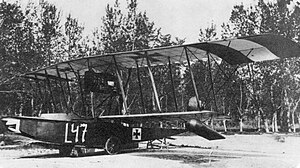Lohner T.I
| Lohner T.I | |
|---|---|

| |
| Role | Flying Boat |
| Manufacturer | Lohner |
| Designer | Karl Paulal [1] |
| First flight | 11 Jan 1915 [2] |
| Introduction | 24 May 1915 [3][note 1] |
| Primary user | |
| Number built | 33 [3] [note 2] |
| Variants | Lohner Tl, Lohner R |
| Wingspan | 16.2 m (53 ft 2 in) [6][7] |
| Engine | 140-180hp various [note 3] |
| Armament | sometimes a front flexible Schwarzlose 200 kg (440 lb)[6] of bombs |
| Crew | 2 |
| Max Speed | 105 km/h (65 mph)[8][6][7] |
| Climb | 910 m (3,000 ft) in 18:00[6] 1,000 m (3,280 ft) in 15:00[7]-20:00[6] |
| Range | 650 km (400 mi)[7] |
| Endurance | 4:00 [8] - 6:30[7] |
The Lohner company called this plane the Type T, but the Austro-Hungarian Navy called it the Type L. It looked much like the earlier Lohner E, but it was larger and had a more powerful engine. Pilot and observer sat side-by-side, with the observer on the right. On some planes the observer was armed with a swiveling Schwarzlose machine-gun. The Type T's were widely used in the Adriatic and over the Italian mainland, making up much of the KuK Kriegsmarine's inventory in 1915 and 1916.
Later orders in 1915 were fulfilled by the modified Lohner Tl, where 'l' means Leicht or light. Of the 107 Type L's completed, 33 were the six-bay Type T and 74 were of the lightened four-bay Type Tl.[7]
When a Type T (L40) was captured by the Italians on 27 May 1915, it was analyzed and led to the Macchi L.1 flying boats.[5] (The Macchi L.1 was almost a direct copy.[9])
In 1915, the Type L accounted for 41 of 42 planes accepted by KuK Kriegsmarine; in 1916, 64 of 114. 107 were built in total, including two that were sent to Germany for evaluation, of which about 2/3 were built or finished by UFAG.[3] The type served through the end of the war, though slow attrition through accidents and combat losses meant that only a few survived into the second half of 1918, and only seven were on hand on 7 Oct 1918.[10]
For more information, see Wikipedia:Lohner L.
Timeline

Game Data
Wings of Glory
| Version | Availability | Maneuver | Damage | Dmg Points | Max Alt. | Climb |
|---|---|---|---|---|---|---|
| unarmed | 15Q2-end | XB | --- | 12 | 10? | 8 |
| armed | XB | B | 12 | 10? | 8 |
Plane and Crew Cards
Card Links
Miniatures and Models
1:144 Scale
- Shapeways Paintable:
- Typical: Columbia Aerodrome, Reduced Aircraft Factory
- L78: Columbia Aerodrome
- with bombs: Columbia Aerodrome
1:285/6mm/1:288 Scale
- Shapeways: Reduced Aircraft Factory
Resources
Orthographic Drawings
References
- Notes
- ↑ A flight of three Type T's attacked Ancona and Venice on the first day of declared war.[3]
- ↑ 107 total T's, including the Tl's.[3] Other sources give different numbers: 108[4] - 160[5]
- ↑ Nine different engines were used: 53% with the unreliable 150hp Rapp, but also 140-150hp Hiero, 140-180hp Daimler, and 150hp Praga V-12.[2]
- Citations
- Bibliography
- Gregory Alegi, Windsock Datafile 99: Lohner TI/Macchi L1. Great Britain: Albatros Publications, Ltd., 2003. ISBN 1-902207-54-8
- Enzo Angelucci, ed. The Rand McNally Encyclopedia of Military Aircraft, 1914-1980. New York: The Military Press, 1983 edition. ISBN 0-517-41021-4.
- Kenneth Munson, Bombers: Patrol and Reconnaissance Aircraft, 1914-1919. New York: The MacMillan Company, 1968, Blandford Press Ltd. ISBN 978-0753721711
- Heinz J. Nowarra, Bruce Robertson, and Peter G. Cooksley. Marine Aircraft of the 1914-1918 War. Letchworth, Herts, England: Harleyford Publications Limited, 1966. ISBN 0900435070




